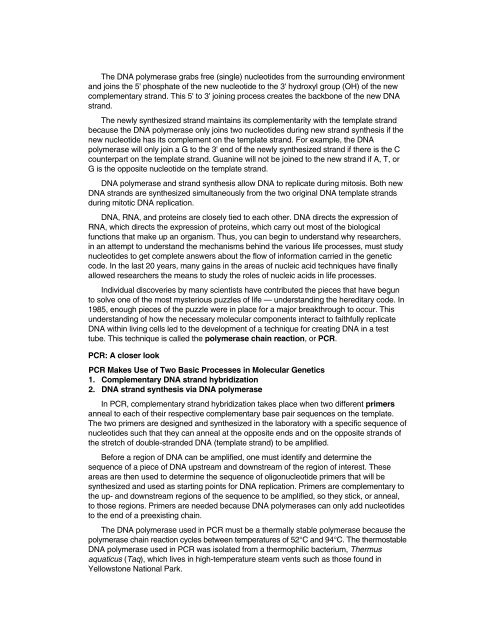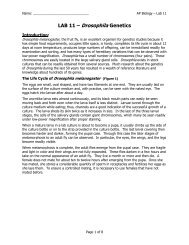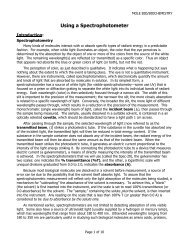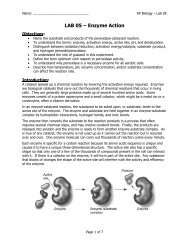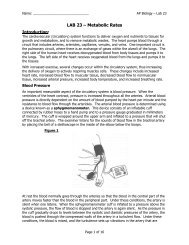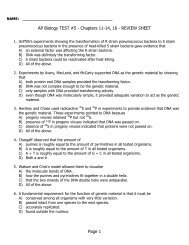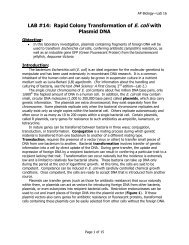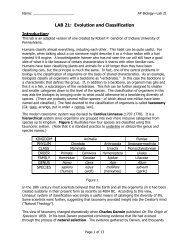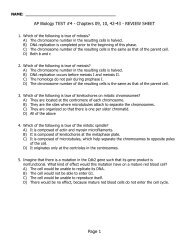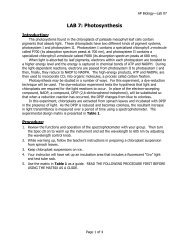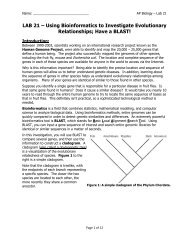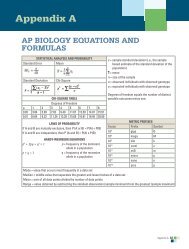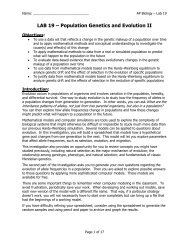Crime Scene Investigator PCR Basics⢠Kit
Crime Scene Investigator PCR Basics⢠Kit
Crime Scene Investigator PCR Basics⢠Kit
You also want an ePaper? Increase the reach of your titles
YUMPU automatically turns print PDFs into web optimized ePapers that Google loves.
The DNA polymerase grabs free (single) nucleotides from the surrounding environment<br />
and joins the 5' phosphate of the new nucleotide to the 3' hydroxyl group (OH) of the new<br />
complementary strand. This 5' to 3' joining process creates the backbone of the new DNA<br />
strand.<br />
The newly synthesized strand maintains its complementarity with the template strand<br />
because the DNA polymerase only joins two nucleotides during new strand synthesis if the<br />
new nucleotide has its complement on the template strand. For example, the DNA<br />
polymerase will only join a G to the 3' end of the newly synthesized strand if there is the C<br />
counterpart on the template strand. Guanine will not be joined to the new strand if A, T, or<br />
G is the opposite nucleotide on the template strand.<br />
DNA polymerase and strand synthesis allow DNA to replicate during mitosis. Both new<br />
DNA strands are synthesized simultaneously from the two original DNA template strands<br />
during mitotic DNA replication.<br />
DNA, RNA, and proteins are closely tied to each other. DNA directs the expression of<br />
RNA, which directs the expression of proteins, which carry out most of the biological<br />
functions that make up an organism. Thus, you can begin to understand why researchers,<br />
in an attempt to understand the mechanisms behind the various life processes, must study<br />
nucleotides to get complete answers about the flow of information carried in the genetic<br />
code. In the last 20 years, many gains in the areas of nucleic acid techniques have finally<br />
allowed researchers the means to study the roles of nucleic acids in life processes.<br />
Individual discoveries by many scientists have contributed the pieces that have begun<br />
to solve one of the most mysterious puzzles of life — understanding the hereditary code. In<br />
1985, enough pieces of the puzzle were in place for a major breakthrough to occur. This<br />
understanding of how the necessary molecular components interact to faithfully replicate<br />
DNA within living cells led to the development of a technique for creating DNA in a test<br />
tube. This technique is called the polymerase chain reaction, or <strong>PCR</strong>.<br />
<strong>PCR</strong>: A closer look<br />
<strong>PCR</strong> Makes Use of Two Basic Processes in Molecular Genetics<br />
1. Complementary DNA strand hybridization<br />
2. DNA strand synthesis via DNA polymerase<br />
In <strong>PCR</strong>, complementary strand hybridization takes place when two different primers<br />
anneal to each of their respective complementary base pair sequences on the template.<br />
The two primers are designed and synthesized in the laboratory with a specific sequence of<br />
nucleotides such that they can anneal at the opposite ends and on the opposite strands of<br />
the stretch of double-stranded DNA (template strand) to be amplified.<br />
Before a region of DNA can be amplified, one must identify and determine the<br />
sequence of a piece of DNA upstream and downstream of the region of interest. These<br />
areas are then used to determine the sequence of oligonucleotide primers that will be<br />
synthesized and used as starting points for DNA replication. Primers are complementary to<br />
the up- and downstream regions of the sequence to be amplified, so they stick, or anneal,<br />
to those regions. Primers are needed because DNA polymerases can only add nucleotides<br />
to the end of a preexisting chain.<br />
The DNA polymerase used in <strong>PCR</strong> must be a thermally stable polymerase because the<br />
polymerase chain reaction cycles between temperatures of 52°C and 94°C. The thermostable<br />
DNA polymerase used in <strong>PCR</strong> was isolated from a thermophilic bacterium, Thermus<br />
aquaticus (Taq), which lives in high-temperature steam vents such as those found in<br />
Yellowstone National Park.<br />
52


